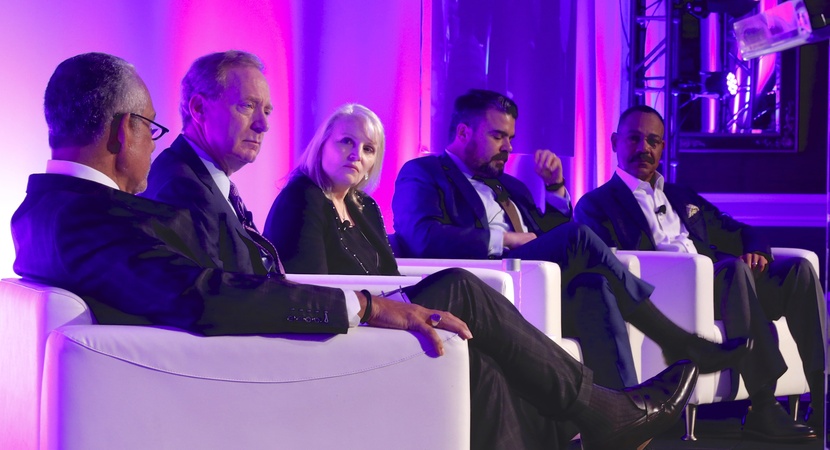
Past Chairs reflect on what LCLD has accomplished and the challenges that remain. From left: Robert Grey (moderator), Brad Smith, Laura Stein, Wally Martinez, and Rick Palmore. (Photo by Joe Mahoney)
LCLD President Robert Grey moderated a panel comprised of the first four Chairs of the Leadership Council on Legal Diversity. Excerpts of their comments revealed both a pride about the accomplishments of LCLD in its first ten years, but more importantly, a recognition that much more works lies head for the organization. The panelists also offered their take on what it means to be leaders in diversity and inclusion.
Rick Palmore set the stage for the discussion, recalling a meeting in Scottsdale, Arizona where the vision for LCLD was introduced.
"At our 'meeting in the desert' in 2008, we realized we needed not to point fingers," said Palmore, "but to get law firms and corporate legal departments in the same room, and have full and frank discussions about what the challenges are and how we needed to move forward. We needed the leaders of the organizations, in positions of influence, to be engaged to make change."
Early on in the panel discussion, LCLD Chair Laura Stein gave her definition of an inclusive leader. "It means realizing that we're all on the same team. No 'A team. No 'B team.' Everybody is valued and there for a reason, and everybody has something to contribute."
Former Chair Brad Smith emphasized the excitement around the early vision and the clarity of that vision: "It helps to know your unique proposition and it's the vision that Rick Palmore had a partnership between the law firm and the general counsel, working together and not banging on each other. Also, we recognized that it would be a significant step not only for 10,000 individuals to benefit from LCLD, but for each of those 10,000 to reach out and help ten more, so that 100,000 are benefitting. That was a strategy, we believed, that had a hope of making a real difference."
"What's really unique about this organization," said LCLD's second Chair Wally Martinez, "is that it activates, encourages, and develops the next generation. Its ultimate objective is not LCLD itself. It's to change the sobering statistics so that all the fantastic talent in this profession can thrive.
"We have to continue investing in and developing and supporting the next generation of leaders because that's what catches fire," said Martinez.
Stein offered a further refinement of the potential of LCLD: "We do feel good about the first ten years, but there are still challenges. We need not only to develop talent, we need to develop ourselves as leaders and help develop the cultures of our organizations_sharing what's working to advance diversity and inclusion."
Brad Smith, who is acknowledged as the author five years ago of the "10,000 in ten years" goal for LCLD, said this: "It's a matter of staying focused, year by year, constantly going back and looking at the numbers. "(He cited an increase in diverse representation on Microsoft's law firms' management committees from 31% to 42% in three years.) "It's all about incremental progress, measured and sustainable."
Rick Palmore agreed with the view that "progress is incremental," but added that it must be coupled with "audacious goals", like the one articulated by Smith of hitting the objective of 10,000 careers advanced in ten years: "Just because it's incremental, it doesn't mean it's not a passionate endeavor for us."
Smith: "Yes, big goals. And sustainable, incremental, measured progress, every year to get there."
Moderator Robert Grey reminded the audience of the source of power of LCLD: "No change happens in any organization unless it is driven actively by the CEO, MP, or GC, which is why an organization comprised of the top leaders willing to put their time, money, and credibility behind an initiative is a potent force for change."
And, looking to the future, Brad Smith posed a final question (and challenge) for all gathered:
"What does the legal profession need from LCLD in the 2020s? What is the right set of goals to pursue? The new generation has different expectations. They expect their voices to be heard."


